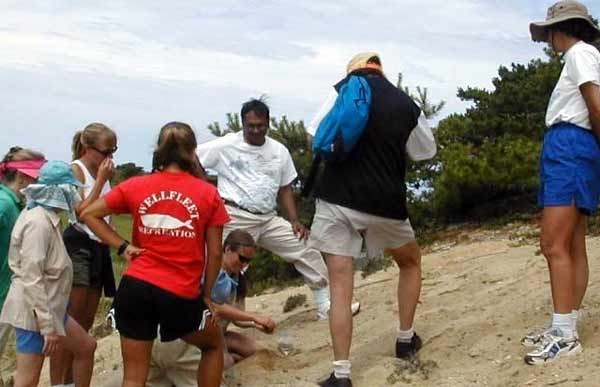Terrapin Field School Wraps Up — 29 June 2001
Our terrapin field school wrapped up on Friday with a long string of discoveries and successes to its credit. During three days of field work, including a half-day interlude to learn about box turtles, this enthusiastic group found 28 individual terrapins. Eighteen were recaptures and ten were seen for the first time. They located 16 nests, six of which held viable eggs and were subsequently protected with predator excluders.
  With volunteer extraordinaire Liz Moon (left) in the lead, the team of Carol, Adriana, and MaryBeth found Terrapin 760 as she finished laying Nest 103 in the west tire track of Lieutenant Island’s 5th Avenue. They waved down a large delivery truck speeding in her direction and plucked #760 from its path. She has an interesting history, as do most diamondback terrapins. On 3 July 1999, Terrapin 760 was run over by a car. Her carapace was cracked and her right bridge was broken, top and bottom. With full use of all her limbs, we decided to release her back into the salt marsh. When the field school found her nearly two years later, she had completely healed. With volunteer extraordinaire Liz Moon (left) in the lead, the team of Carol, Adriana, and MaryBeth found Terrapin 760 as she finished laying Nest 103 in the west tire track of Lieutenant Island’s 5th Avenue. They waved down a large delivery truck speeding in her direction and plucked #760 from its path. She has an interesting history, as do most diamondback terrapins. On 3 July 1999, Terrapin 760 was run over by a car. Her carapace was cracked and her right bridge was broken, top and bottom. With full use of all her limbs, we decided to release her back into the salt marsh. When the field school found her nearly two years later, she had completely healed.
  After nesting checks, we waded out into Blackfish Creek to test a seine (read: insane) net across the narrow rapids. In three years of experimenting with this technique, results have always been ... well ... ahh ... disappointing. It’s one of those “But it should work” ideas that bedevil researchers in pursuit of the elusive terrapin. Our two-hour seining expedition netted one large female, #215, who had been seen nesting that same morning. The team did managed to dip net two juvenile terrapins, which had evaded the big net, staffed here by Leah, MaryBeth, Ed, Burt, Jean, and Ramace. After nesting checks, we waded out into Blackfish Creek to test a seine (read: insane) net across the narrow rapids. In three years of experimenting with this technique, results have always been ... well ... ahh ... disappointing. It’s one of those “But it should work” ideas that bedevil researchers in pursuit of the elusive terrapin. Our two-hour seining expedition netted one large female, #215, who had been seen nesting that same morning. The team did managed to dip net two juvenile terrapins, which had evaded the big net, staffed here by Leah, MaryBeth, Ed, Burt, Jean, and Ramace.
By the second day, researcher Maureen Ryan (below left) could turn over the hard processing work to field school students and just take notes as Adriana measures the 5-year-old juvenile female she captured in the rip.

No terrapin field course would be complete without a canoe expedition. Barbara guides her boat back into the lee of Shirt Tail Point and safety from a sudden kick-up of wind out of the northwest. Our five-canoe caravan was blown quite convincingly into the southeast corner of Chipman’s Cove, and we clawed our way back to the town pier. Just as one trip leader explained how no canoe had ever capsized in conditions like this — you guessed it — one boat got beam to wind and wave and turtled. Your diarist was already in the water towing two other canoes back across the cove and dodged his photojournalist duties in favor of rescuing the paddlers. The pictures would have been spectacular (use your imagination), but the bureaucratic paperwork would not have been worth the Pulitzer.

The school ended in grand style. The team of Julia, Adriana, and Barbara discovered a freshly laid but vulnerable nest on isolated Crescent Island. Not only is this barrier beach predator heaven where 95 to 100% of nests are destroyed, but Nest 112 had been dug in an area at high risk to tidal surge. We excavated the site and harvested the pinkish white eggs, preserving their original orientation during transport and relocation.

In the photo below, Burt — under the watchful gaze of Maureen and Julia — deposits one of the relocated eggs in a newly dug nest on Turtle Point where they will have a much better chance of hatching. To make sure they make that transition from egg to hatchling, Barbara spent the post-field school afternoon guiding her younger children in the construction of nest protectors, which were quickly installed on each viable nest.

In the afternoon wrap-up session, the group decided to schedule a reunion in early September to watch their adopted babies emerge and join their rightful place in the Land of Ooze alongside all their paludal pals.

|